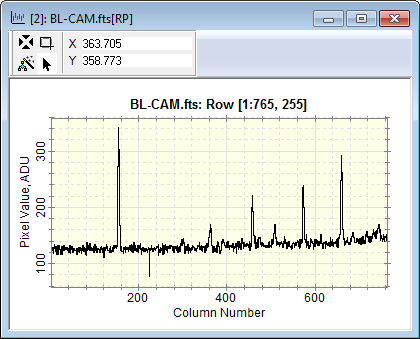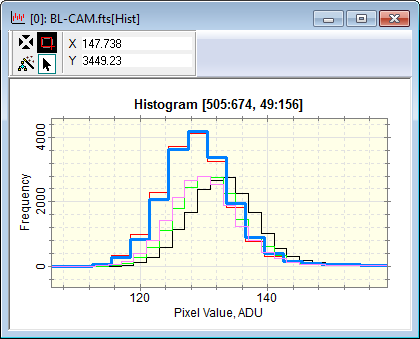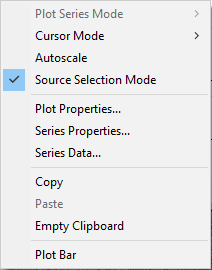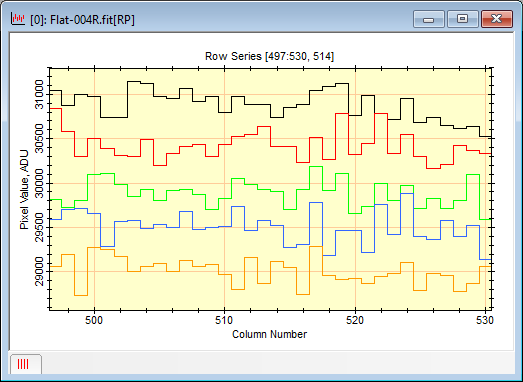
Plot Windows
Plot Windows display 1-D data in the form of a 2-D graph, or "plot" and provide several tools for interactively working with the data. The different aspects of plotting data are described in Plotting Images and Data.
The pictures below show a typical Plot Window with the Plot Bar at the top border and the Plot Animation Bar at bottom border. The Plot Bar can be shown or hidden using theToolbar command in the Plot menu or the option of the Image Plot Properties dialog. In the second picture, the window is changed to Overplot mode using the command in the Plot Context Menu. You can control whether Mira prompts you to confirm closing a Plot Window using the check list item in the General Properties dialog.
This is a typical Plot Window showing a single row plotted for an image :

A Plot Window can contain more than 1 series of data, such as multiple images, multiple rows, or a scatter plot of table data. You can also create multiple series using copy + paste to add data from other Plot Windows. In such cases, you can choose from 2 modes to view the multiple series:
Animate Mode: One plot series is shown at one time. You can switch between series using the Plot Animation Bar.
Overplot Mode: All plot series are displayed at once on the same set of axes.
These alternatives are shown in the pictures below. To create these plots, a column plot was made for a single slice through an image set containing 5 images. This makes 5 plot series—one from each image.
This window has 5 plot series. In this mode, only 1 series is displayed at a time.

This picture shows all 5 plot series at the same time. The color assigned to each series is configured in the Plot Properties dialog. The Plot Series Properties also can be altered afterward using the Plot Properties dialog.

There are many ways to create Row Profile Plots and Column Profile Plots like those shown above.
The Plot Window provides a number of toolbars for working with the plotted data.
The top border of the Plot Window has a Plot Bar which acts as a control center for working with the displayed data. This is similar in function to the Image Bar of an Image Window. The Plot Bar has buttons for changing the appearance of the data and a coordinate readout which is continuously updated when the mouse pointer is over the Plot Window.
If multiple plot series are graphed but displayed individually, the bottom border shows the Plot Animation Bar. The Plot Animation Bar lets you step through or animate through Plot Series in the same way the Image Animation Bar interacts with an Image Set.
All of the profile plots show image intensity versus position or distance. For these types, Mira also provides the following coordinate system options:
The Pixel Coordinates option measures pixel position in column or row [number].
The World Coordinates option measures position in world units such as cm, microns, or other units. If the calibration uses Celestial Coordinates (RA, Dec), then the plot uses [arcseconds] in a relative sense.
To change the default setting, see Plotting in World Coordinates.
Intensity is displayed on the vertical axis of a profile plot and the horizontal axis of a histogram plot. The Intensity Axis label includes the units of intensity if the image header contains such information.
The properties of the plot can be set before the plot is created and changed after the plot is created.
The Image Plot Properties control how the plot is created from the image. This includes, for example, whether Pixel or World Coordinates are used and what colors are used for multiple plot series.
The Plot Properties control the way the finished plot is displayed. You can change the axis scaling, colors, fonts, labels, tick marks, and other properties using the pages of the Plot Properties dialog.
The Plot Series Properties define the way the data in the plot series are displayed. This includes the size, color, and style of markers and lines.
Right clicking inside a Plot Window opens a Context Menu containing some useful commands. This shows the Plot Series Mode submenu used to create the different plots shown above.

The commands in the Context Menu are a subset of those in the Plot window's menu.
Accelerators in the table below execute commands when a Plot Window has focus.
Plot Accelerators
|
Ctrl+A |
Opens the Plot Properties dialog for setting the Properties for the Plot window and the plotted data. |
|
Ctrl+Shift+A |
Open the Plot Series Properties dialog. |
|
Ctrl+C |
Executes the Copy command, which copies the window's plot series to the Windows clipboard. |
|
Ctrl+N |
Executes the New command, which displays the New Document dialog. |
|
Ctrl+O |
Executes the File > Open command, which displays the Open dialog. |
|
Ctrl+P |
Prints the Plot Window. |
|
Ctrl+R |
Opens the General Properties dialog. |
|
Ctrl+V |
Executes the Paste command to paste plot series from the clipboard into the current Plot Window. |
To view the numeric plot data, user the Plot Series Data command. This opens the numeric data for all series into a grid window. The window has buttons to save, print, and copy the data to the Windows Clipboard.
Plot Window data can be saved to a text file using the Save as Text command. This command is available from the File menu when a Plot Window is the top-most view.
The intensity profile of an image can be plotted using either the Column or Row Profile command or the Line Profile tool. There are some unique capabilities offered by each method.
Comparison of Profile Plot Types
|
Property |
Column or Row Profile |
Line Profile |
Radial Profile |
|
Uses the Image Cursor to sample pixels |
|
|
|
|
Uses the mouse pointer to sample pixels |
|
|
|
|
Uses Pixel coordinates |
|
|
|
|
Uses World coordinates |
|
|
|
|
Append series from parallel pixel samples |
|
|
|
|
Append series using Copy / Paste |
|
|
|
|
Profile must be parallel to rows or columns |
|
|
|
|
|
|||
All of the profile plots show image intensity versus position or distance. For these types, Mira also provides the following coordinate system options:
Use Pixel Coordinates to measure pixel position in column or row [number].
Use World Coordinates to measure position in world units like cm, microns, or angular units of arcseconds.
To change the default setting, see Plotting in World Coordinates.
Intensity is displayed on the vertical axis of a profile plot and the horizontal axis of a histogram plot. The Intensity Axis label includes the units of intensity if the image header contains such information.
A Plot Series is a collection of data points collected together. Usually these collections are related. For example, in a Column Profile plot, a plot series is a single sample of intensity versus position along a single line. A different series might be a sample of points parallel to the first, taken along a different column. Profile plots can show a single plot series or multiple plot series from samples along other lines. When multiple series are displayed in the same Plot Window, they may be visualized in the following ways:
In Animate mode, the active plot series is displayed singly. The other series may be viewed by stepping or animating through the set using the Plot Animation Bar much the same way the Image Animation Bar steps through an Image Set.
In Overplot mode, all plot series are displayed simultaneously as an "Overplot" on the same set of axes. If only 1 plot series is displayed, this is the default mode. In this mode, the Plot Animation Bar is hidden.
To change the Plot Series Mode, see Changing the Plot Series Mode.
To display or save the data in the plotted series, see Plot Series Data.
Adjacent lines (columns or rows) may be combined to form a single line to be plotted. The method of combining is controlled by the Plot Averaging Mode command. The name of the plot appears in the command menu from which the plot is created (see Plotting an Averaged Line).
Image Plot Properties control how the plot is created from the image. This includes, for example, whether Pixel or World Coordinates are used and what colors are used for multiple plot series. These settings are changed using the Image Plot Properties dialogs
Plot Properties control the way the finished plot is displayed. You can change the axis scaling, colors, fonts, labels, tick marks, and other properties using the pages of the Plot Properties dialog.
The Plot Caption is the text above the plot box and below the top window border. The Plot Caption tells you information about what was plotted. In particular, it may list the beginning and ending coordinates in (x,y) form for a Line Profile Plot or it may list the column and row range for a Column Profile or Row Profile plot. Below are some examples that show how to read the column,row range in the plot caption:
Example Regions Listed in the Plot Caption
|
[125:140, 180:182] |
Columns 125 through 140, inclusive and rows 180 through 182, inclusive. This describes 16 columns and 3 rows. |
|
[125:140, 180] |
Columns 125 through 140, inclusive and row 180. This describes 16 columns and 1 row. |
You can change the plot caption using the Labels page of the Plot Properties dialog.
The Plot Window caption lists the image name from which the plot was created and gives an abbreviation that describes the type of plot. The plot type is abbreviated and appended to the window caption in square brackets. For example, a Row Plot is signified by [RP] appended to the Plot window caption. These suffixes appear in the window list of the Window menu and in the Multi-tab Interface along the bottom border of Mira's main window.
|
Note |
After using the Windows Copy + Paste protocol to add series to a plot window, the window caption may not accurately reflect the content of the window. You can change the caption using the Plot Properties command. |
Source Image Selection involves activating the image that provided the source data shown in the Plot Window. Image activation involves bringing the target image to the top of the image set and bringing its Image Window to the top of the window stack. When the Plot Window is in Source Selection Mode as indicated in Plot > View pull-down menu or Plot Context menu, double-clicking on a plot series activates the source image in its Image Window and centers the Image Cursor at the location of the data used for that plot series.
For example, suppose several Image Windows and several Plot Windows are open, and a Plot Window being analyzed shows the data below. The question may arise as to the appearance of the source image at the location of the data set graphed in red:

With Source Image Selection enabled (checked in the Plot > View pull-down menu or the right-click Plot Context menu shown above), the source image for the red data series may be activated by double-clicking on the red series. In this case, the double-clicking the red plot series activated the second image of the image set shown below and positioned the Image Cursor on the region where the source data were obtained. Note that the position of the image cursor marks the central location of the source data but not the length of the data series shown in the Plot Window.

Plotting Commands, Plot Properties, Image Plot Properties, Printing Properties, Plot Bar, Plot Animation Bar, Image Windows, Create Plot from Table Data, Save Plot as Text File